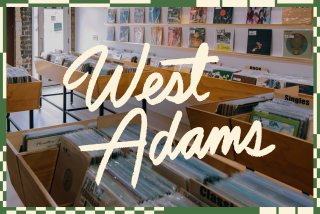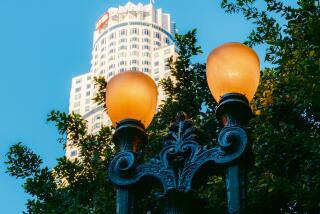Long Beach District Draws Young Buyers : Palm-lined streets, affordable prices revive interest in Wrigley neighborhood.
- Share via
Until a decade ago, the sleepy Wrigley district of Long Beach was headed into decline. The half-century-old mix of custom Spanish, Tudor and Colonial Revival homes fell out of favor with younger couples, many of whom were attracted instead to newer housing tracts.
Then a change began to take place. Younger home buyers rediscovered the allure of the district’s quiet, palm-lined streets and solidly built houses at affordable prices.
“It has a lot of character,” said Chris Kowal, an eight-year resident whose 1932 house retains an original chute where ice blocks were delivered in the pre-refrigerator age. “It’s not like moving into a new tract, where all the houses look the same.”
Real estate agents say the area named for chewing gum magnate William Wrigley has become very popular over the past couple of years, particularly among first-time home buyers.
“It’s in great demand,” said Len Crites of Coldwell Banker. “It has a predominance of Spanish-style homes that are real popular right now. Most of the homes are small--two bedroom and one bath--and they’re perfect for young couples starting out.”
Situated for Commuting
Sindy Verdugo of Landmark Properties-Century 21 said the area is attracting out-of-town home buyers priced out of fashionable neighborhoods like those in Torrance or the Belmont Heights section of Long Beach.
Working couples appreciate the area because its central location is well situated for commuting either to Los Angeles or business centers in Orange County.
Also, residents say they hope that some of the luster of the city’s revitalized downtown two miles to the south will rub off on Wrigley. Long Beach’s downtown is undergoing a major high-rise building boom that has brought thousands of new jobs to the city.
A $752-million, 22-mile light-rail line to Los Angeles is being constructed along Long Beach Boulevard, Wrigley’s eastern boundary. And a popular bicycle trail to the beach runs along the Los Angeles River, at its western edge.
Wrigley “is one of the most up-and-coming areas of the city,” said Long Beach City Councilman Ray Grabinski, who represents the district.
The district, however is not without its troubles.
For years, prostitutes have prowled the sidewalk in front of a row of low-priced motels along Pacific Coast Highway, the district’s southern edge. Residents complain that hookers sometimes drive into the neighborhood with their customers.
The southeast area of Wrigley is plagued by some older, run-down apartment buildings, and crime rates are higher. The area outside of Wrigley on the east side of Long Beach Boulevard is considered so rough that firefighters briefly adopted a policy this year of refusing emergency runs in the area without police escort.
And last summer, the neighborhood was invaded by millions of midges--non-biting mosquito-like bugs--that breed in the nearby river bottom.
Wrigley residents say they are combating the problems. They resurrected their homeowner association about three years ago and built it into a potent force that politicians credit as being one of the most powerful voices of its kind in the city.
Residents picketed along Pacific Coast Highway’s motel strip last summer to try to hamper the activities of prostitutes. The City Council recently enacted a law based on a Wrigley-backed idea that will allow the city to yank the permits of motels that operate as bases for prostitution.
Christmas Tree Lane
While battling blight, the Wrigley Assn. also has done its share to show off the virtues of the district.
One of its most successful efforts is the revival of a four-block-long “Christmas Tree Lane.” A treasured annual event in the 1950s and 1960s, residents decorated a park median and draped thousands of holiday lights in the stately cedar trees along Daisy Avenue. Caroling, the Christmas display and free candy canes attracted a nightly throng of slow-moving cars with children’s faces pressed against the windows.
Jeff Baker, a 40-year Wrigley resident who heads the association, said residents’ efforts are paying off in soaring home prices.
“Property values are increasing by leaps and bounds. It’s just amazing,” he said. Areas that had been considered marginal, such as those near Pacific Coast Highway, are now being recommended by real estate agents, he said.
Houses are being listed from $170,000 to $250,000, having leaped $50,000 or more in the past two years.
Ethnically Diverse Group
“The biggest change is the people who are moving in . . . young professionals, engineers, doctors,” realtor Verdugo said. The area traditionally has been an ethnically diverse group composed of working-class couples and retirees.
Coldwell Banker’s Crites said home prices have risen so fast in the past year that some first-time buyers may be priced out. The same two-bedroom, Spanish-style house that was considered overpriced last summer at a list price of $183,000 recently sold for $207,000, he said.
“I think Wrigley might be getting out of reach now for a lot of people,” Crites said.
The rising prices reflect a reborn appreciation of the quality of many of the older homes. Though modestly sized, the houses feature hardwood floors, mahogany trim, tile roofs, oversized fireplaces and coved plaster ceilings.
The area is undergoing a renovation boom. Many of the old homes, recently sold after being rented for years or lived in by a longtime owner, are a do-it-yourselfer’s challenge.
Historical Preservation
“It’s a quiet area. Everyone tries to take care of their house,” said Ignacio Mireles, looking up as he planted divots of St. Augustine turf in the front yard of his four-bedroom home. Mireles and his wife, Irma, estimated that the house they bought six years ago for $105,000 has easily doubled in value.
Some residents have launched their own historical preservation movement.
The residents on two blocks of Eucalyptus Avenue are attempting to win designation for it as a historical district. The move would protect the architectural character of the neighborhood and make changes in the appearance of houses subject to approval by the city Cultural Heritage Commission.
Lee Davis, one of the organizers of the drive, said the two blocks have the oldest, most valuable and beautiful homes in the district. The two dozen homes were built in 1929 by a development company under the control of Wrigley. While other contractors built homes throughout the district, the Wrigley name was applied to the entire area, she explained.
“I like Wrigley because all the areas are custom made,” she said. “You feel you are in Spain (or) Italy. It has so much romantic charm.”
Davis lives with her husband and son in their dream home. She said they bought the two-bedroom house with a library from the original owner, a woman who lived there 60 years, ever since her father gave her the house as a wedding gift. The doorways are arched, the fireplace is sheathed in marble and the sunken living room steps up to the dining room.
While Wrigley’s residential areas are rebounding, the commercial district is lagging. Many of the businesses along the two main corridors--Willow Street and Pacific Avenue--are older, mom-and-pop-type operations that are long on practicality and short on yuppie slickness.
Councilman Grabinski, however, predicted that Pacific Avenue may evolve into one of the city’s most chic shopping districts once merchants realize they are a few blocks from Wrigley’s increasingly upscale crowd.
AT A GLANCE
Population 1988 estimate: 30,791 1980-88 change: + 15%
Median age: 31 years
Racial/ethnic mix White: 40.7% Black: 26.3% Latino: 22% Other: 11%
Annual income Per capita: $8,969 Median household: $18,173
Household distribution Less than $15,000: 42.5% $15,000 - $30,000: 31.8% $30,000 - $50,000: 18.4% $50,000 - $75,000: 5.2% $75,000: + 2%
More to Read
Sign up for Essential California
The most important California stories and recommendations in your inbox every morning.
You may occasionally receive promotional content from the Los Angeles Times.






